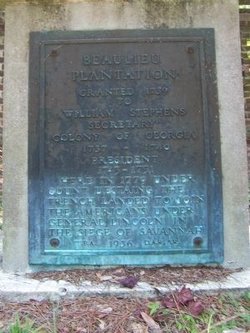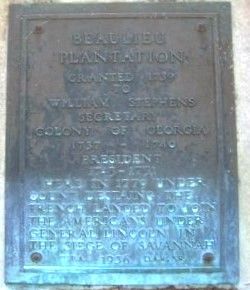BEAULIEU PLANTATION
GRANTED 1739
TO
WILLIAM STEPHENS
SECRETARY
COLONY OF GEORGIA
1737-1740
PRESIDENT
1743-1751
HERE IN 1779 UNDER
COUNT D'ESTAING THE
FRENCH LANDED TO JOIN
THE AMERICANS UNDER
GENERAL LINCOLN IN
THE SEIGE OF SAVANNAH
WPA 1936 D.A.R. S.R.
No memorials to William Stephens exist today. His estate at Beaulieu (which he spelled Bewlie) has become part of Savannah's suburban landscape like so many neighboring plantations, & his grave site has also disappeared. None of the 24 squares in Savannah bear his name. There are no streets named after Stephens. No statues or historical markers commemorate him. No portraits of Stephens exist to show what he looked like; the only description of his physical appearance comes from his son Thomas, author of The Castle Builders (1759), who claimed his father "was rather of a large stature, yet, as to his person, he was handsome enough, and his complexion & countenance were florid & open".
Col William Stephens, son of Sir William Stephens, Lieutenant Governor of the Isle of Wight, and Elizabeth, was born at Bowcombe, Isle of Wight. On Jan 28, 1671, & received an extensive education, which included a masters degree from King's College, Cambridge & entrance to the Middle Temple, for the study of law, in 1691.
In 1696 he married Mary, 2nd daughter of Sir Richard Newdigate & Mary, daughter of Sir Edward Bagot, bart., of Asbury. They had seven sons & two daughters.
Children:
1. William Stephens, Jr became a minister of the Church of England in 1736. He died on Jan 27, 1750.
2. Henry Stephens, (1699-1742) lived in the East Indies for several years & died there in 1742. He left his estate to his brother Thomas.
3. Thomas Stephens (1702-1767) came to America in 1737 six weeks after his father.
4. Elizabeth Stephens Ball. (Spouse: Benedict Ball)
5. Edward Stephens
6. Richard Stephens
7. John Stephens
8. Mary Stephens
9. Newdigate Stephens (1711-1757)
He entered Parliament for Newport, Isle of Wight in 1702, became an officer in the Island militia and before 1706 rose to the rank of Colonel. He was unseated in 1727.
In 1728, he found employment in Scotland as an agent for the York Building Co, owned by one Colonel Horsey. Arriving in Scotland on March 28, 1729, he devoted himself to timber. Three years later he had to leave Scotland.
After a short residence at Penrith, Stephens was ask by Col Horsey in 1736 to execute a land survey in South Carolina. There he became reaquainted with James Edward Oglethorpe, whom he had known in parliment. Stephens returned to England & submitted a report of his travels to the Trustees of colonial Georgia. The members expressed delight with Stephens report & hired him, then in his mid-sixties, as their secretary.
Stephens, arrived in GA on the Mary Anne via Charlestown, on Nov 1, 1737, and found the colony distracted by social quarrels and rivalries in which he acted as mediator. Malcontents criticized the Trustees policy of tail-mail land tenure, the prohibition of rum & slaves. Stephens urged the Trustees to accept full female inheritance, but Oglethorpe convinced his associates to maintain the tail-mail policy.
Then in 1740 the Trustees placed Stephens & Thomas Jones, the new Savannah storekeeper, in charge of finances to control Oglethorpe's spending frenzy & poor record keeping habits. The Trustees divided the colony into two counties & made Stephens President of Savannah while Oglethorpe directed Frederica, dealing with the Creeks, defense concerns, & a war with Spain in 1739.
Stephens support of the Trustee policies reduced his effectiveness among the Malcontents. Even Thomas, his son, joined the Malcontents after a quarrel with Oglethorpe. Stephens became so angry with his wayward child that he transferred his Georgia lands to another son, Newdigate. The original land grant listed Thomas & William as caretakers of the 500 acre plantation & gave the estate to Thomas & his male descendants upon William's death.
Oglethorpe left the colony in 1743, never to return. The Trustees appointed Stephens, at age seventy-one, as President of the entire colony. Stephens served as Secretary until March 1750 & as President until the spring of 1751. He led GA well in the absence of a governor or much involvement from the Trustees. He died in August 1753 & was buried at his plantation, but the family sold the estate in 1772. It later served as the landing site for French troops during the Siege of Savannah in Oct 1779.
Biography added by Nancy Coffey, #47994929
**********************
Photo of Plaque taken at Beaulieu Plantation, Sept 19, 2012 by Nancy Coffey.
As stated on the historic marker, Count d'Estaing was, Count Charles Henri
d'Estaing. General Lincoln was, Major General Benjamin Lincoln.
BEAULIEU PLANTATION
GRANTED 1739
TO
WILLIAM STEPHENS
SECRETARY
COLONY OF GEORGIA
1737-1740
PRESIDENT
1743-1751
HERE IN 1779 UNDER
COUNT D'ESTAING THE
FRENCH LANDED TO JOIN
THE AMERICANS UNDER
GENERAL LINCOLN IN
THE SEIGE OF SAVANNAH
WPA 1936 D.A.R. S.R.
No memorials to William Stephens exist today. His estate at Beaulieu (which he spelled Bewlie) has become part of Savannah's suburban landscape like so many neighboring plantations, & his grave site has also disappeared. None of the 24 squares in Savannah bear his name. There are no streets named after Stephens. No statues or historical markers commemorate him. No portraits of Stephens exist to show what he looked like; the only description of his physical appearance comes from his son Thomas, author of The Castle Builders (1759), who claimed his father "was rather of a large stature, yet, as to his person, he was handsome enough, and his complexion & countenance were florid & open".
Col William Stephens, son of Sir William Stephens, Lieutenant Governor of the Isle of Wight, and Elizabeth, was born at Bowcombe, Isle of Wight. On Jan 28, 1671, & received an extensive education, which included a masters degree from King's College, Cambridge & entrance to the Middle Temple, for the study of law, in 1691.
In 1696 he married Mary, 2nd daughter of Sir Richard Newdigate & Mary, daughter of Sir Edward Bagot, bart., of Asbury. They had seven sons & two daughters.
Children:
1. William Stephens, Jr became a minister of the Church of England in 1736. He died on Jan 27, 1750.
2. Henry Stephens, (1699-1742) lived in the East Indies for several years & died there in 1742. He left his estate to his brother Thomas.
3. Thomas Stephens (1702-1767) came to America in 1737 six weeks after his father.
4. Elizabeth Stephens Ball. (Spouse: Benedict Ball)
5. Edward Stephens
6. Richard Stephens
7. John Stephens
8. Mary Stephens
9. Newdigate Stephens (1711-1757)
He entered Parliament for Newport, Isle of Wight in 1702, became an officer in the Island militia and before 1706 rose to the rank of Colonel. He was unseated in 1727.
In 1728, he found employment in Scotland as an agent for the York Building Co, owned by one Colonel Horsey. Arriving in Scotland on March 28, 1729, he devoted himself to timber. Three years later he had to leave Scotland.
After a short residence at Penrith, Stephens was ask by Col Horsey in 1736 to execute a land survey in South Carolina. There he became reaquainted with James Edward Oglethorpe, whom he had known in parliment. Stephens returned to England & submitted a report of his travels to the Trustees of colonial Georgia. The members expressed delight with Stephens report & hired him, then in his mid-sixties, as their secretary.
Stephens, arrived in GA on the Mary Anne via Charlestown, on Nov 1, 1737, and found the colony distracted by social quarrels and rivalries in which he acted as mediator. Malcontents criticized the Trustees policy of tail-mail land tenure, the prohibition of rum & slaves. Stephens urged the Trustees to accept full female inheritance, but Oglethorpe convinced his associates to maintain the tail-mail policy.
Then in 1740 the Trustees placed Stephens & Thomas Jones, the new Savannah storekeeper, in charge of finances to control Oglethorpe's spending frenzy & poor record keeping habits. The Trustees divided the colony into two counties & made Stephens President of Savannah while Oglethorpe directed Frederica, dealing with the Creeks, defense concerns, & a war with Spain in 1739.
Stephens support of the Trustee policies reduced his effectiveness among the Malcontents. Even Thomas, his son, joined the Malcontents after a quarrel with Oglethorpe. Stephens became so angry with his wayward child that he transferred his Georgia lands to another son, Newdigate. The original land grant listed Thomas & William as caretakers of the 500 acre plantation & gave the estate to Thomas & his male descendants upon William's death.
Oglethorpe left the colony in 1743, never to return. The Trustees appointed Stephens, at age seventy-one, as President of the entire colony. Stephens served as Secretary until March 1750 & as President until the spring of 1751. He led GA well in the absence of a governor or much involvement from the Trustees. He died in August 1753 & was buried at his plantation, but the family sold the estate in 1772. It later served as the landing site for French troops during the Siege of Savannah in Oct 1779.
Biography added by Nancy Coffey, #47994929
**********************
Photo of Plaque taken at Beaulieu Plantation, Sept 19, 2012 by Nancy Coffey.
As stated on the historic marker, Count d'Estaing was, Count Charles Henri
d'Estaing. General Lincoln was, Major General Benjamin Lincoln.
Family Members
Advertisement
Records on Ancestry
Advertisement








